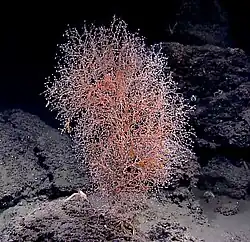Scleralcyonacea
| Scleralcyonacea | |
|---|---|

| |
| Chrysogorgia sp. | |
| Scientific classification | |
| Kingdom: | Animalia |
| Phylum: | Cnidaria |
| Subphylum: | Anthozoa |
| Class: | Octocorallia |
| Order: | McFadden, van Ofwegen & Quattrini, 2022 |
Scleralcyonacea is an order of the class Octocorallia.[1][2]
It combines the traditional taxa Calcaxonia (except the genus Isis), Pennatulacea and Helioporacea, as well as a part of Scleraxonia and a part of Stolonifera, and the genera Ideogorgia and Parasphaerasclera.[1] See below for a more detailed description.
History
A clade combining (primarily) the Calcaxonia, the Pennatulacea and the Helioporacea was identified (but not named) as early as in a 2006 study and in several later studies; it was usually called informally the Calcaxonia-Pennatulacea clade or the Pennatulacea-Calcaxonia clade.[3][4][5][6][1]
In 2019, G. C. Williams proposed (only optionally) calling the Calcaxonia-Pennatulacea clade Calcaxonia (sensu lato),[7] but other authors did not adopt this naming proposal.
The phylogenetic study McFadden et al. 2022 assigned the name Scleralcyonacea and the rank of an order to the Calcaxonia-Pennatulacea clade. The study found Octocorallia to be divided into two monophyletic lineages (both identified already by some earlier studies[3][4]), which the study established as the orders Scleralcyonacea and Malacalcyonacea. Scleralcyonacea was found to contain:
- all taxa formerly assigned to the order Pennatulacea (i.e. the current superfamily Pennatuloidea), to the order Helioporacea (i.e. the current family Helioporidae [sensu lato]) and to the suborder Calcaxonia (inclusive of Dendrobrachia), except the genus Isis (see below);
- and a part of the suborder Scleraxonia and of the (sub)order Stolonifera;
- and the genera Ideogorgia (from the suborder Holaxonia) and Parasphaerasclera (from the suborder Alcyoniina).[8]
While the genus Isis was historically placed within Calcaxonia as a relative of Keratoisididae and Mopseidae, it was found to be unrelated, with the difference in internode growth patterns being identified as phylogenetically informative.[9]
Name
Scleralcyonacea was named after Greek σκληρός (sklēros, transl. hard) and former coral order Alcyonacea, as most of its members contain either an axial skeleton made of calcium carbonate or sclerites fused with calcitic material.[10]
Taxonomy
Scleralcyonacea contains the monophyletic sea pens (superfamily Pennatuloidea) as well as 21 other families and two incertae sedis genera. The order includes the following:[2]
- family Aulopsammiidae Reuss, 1854 [= Litholestidae Bayer & Muzik, 1977] (included in Helioporidae by McFadden et al. 2022) [He]
- family Briareidae Gray, 1859 [Sc]
- family Chelidonisididae Heestand Saucier, France & Watling, 2021 [Ca]
- family Chrysogorgiidae Verrill, 1883 [Ca]
- family Coralliidae Lamouroux, 1812 [Sc]
- family Cornulariidae Dana, 1846 [St]
- family Dendrobrachiidae Brook, 1889 [Ca/Ho]
- family Ellisellidae Gray, 1859 [Ca]
- family Erythropodiidae Kükenthal, 1916 [Sc]
- genus Helicogorgia Bayer, 1981 [Ca]
- family Helioporidae Moseley, 1876 [He]
- family Ideogorgiidae McFadden, van Ofwegen & Quattrini, 2024 [Ho]
- family Ifalukellidae Bayer, 1955 [Ca]
- family Isidoidae Heestand Saucier, France & Watling, 2021 [Ca]
- family Keratoisididae Gray, 1870 [Ca]
- family Mopseidae Gray, 1870 [Ca]
- family Parasphaerascleridae McFadden & van Ofwegen, 2013 [Al]
- family Parisididae Aurivillius, 1931 [Sc]
- superfamily Pennatuloidea Ehrenberg, 1834 [Pe]
- family Pleurogorgiidae Cairns, Cordeiro & Alderslade in Cairns et al., 2021 [Ca]
- family Primnoidae Milne Edwards, 1857 [Ca]
- family Sarcodictyonidae McFadden, van Ofwegen & Quattrini, 2024 [St]
- family Spongiodermidae Wright & Studer, 1889 [Sc]
- genus Stephanogorgia Bayer & Muzik, 1976 [Ca]
Legend (traditional assignment of the taxa):[1] Ca = Calcaxonia, Pe = Pennatulacea, He = Helioporacea, St = Stolonifera, Sc = Scleraxonia, Ho = Holaxonia (sensu stricto), Al = Alcyoniina.
References
- ^ a b c d McFadden, Ofwegen & Quattrini 2022, p. 18.
- ^ a b "WoRMS - World Register of Marine Species - Scleralcyonacea". marinespecies.org. Retrieved 2024-07-14.
- ^ a b McFadden, C. S., France, S. C., Sánchez, J. A., & Alderslade, P. (2006). A molecular phylogenetic analysis of the Octocorallia (Cnidaria: Anthozoa) based on mitochondrial protein-coding sequences. Molecular Phylogenetics and Evolution, 41(3), 513–527.
- ^ a b Quattrini, A.M., Rodríguez, E., Faircloth, B.C. et al. Palaeoclimate ocean conditions shaped the evolution of corals and their skeletons through deep time. Nat Ecol Evol 4, 1531–1538 (2020). https://doi.org/10.1038/s41559-020-01291-1 [1]
- ^ Schierwater, Bernd; DeSalle, Rob (2021-07-08). Invertebrate Zoology: A Tree of Life Approach. CRC Press. p. 176. ISBN 978-1-4822-3582-1. Retrieved 2025-07-09.
- ^ Morrissey, D., Quattrini, A.M. & Allcock, A.L. Analysis of mitogenomes from the family Keratoisididae reveals mitonuclear discordance and the presence of unknown open reading frames. Mar Biol 172, 46 (2025). https://doi.org/10.1007/s00227-025-04600-z
- ^ Williams, Gary. (2019). A new genus and species of enigmatic gorgonian coral from the Ryukyu Archipelago, northwestern Pacific, with a discussion of calcaxonian systematics (Cnidaria, Anthozoa, Octocorallia). Zootaxa. 4701. 417-433. 10.11646/zootaxa.4701.5.2.
- ^ McFadden, Ofwegen & Quattrini 2022, p. 7, 17, 18.
- ^ McFadden, Ofwegen & Quattrini 2022, p. 15.
- ^ McFadden, Ofwegen & Quattrini 2022, p. 21.
Works cited
- McFadden, Catherine S.; Ofwegen, Leen P. van; Quattrini, Andrea M. (14 October 2022). "Revisionary systematics of Octocorallia (Cnidaria: Anthozoa) guided by phylogenomics". Bulletin of the Society of Systematic Biologists. 1 (3). doi:10.18061/bssb.v1i3.8735. ISSN 2768-0819.
Bibliography
- Taxonomic Study of Suborder Calcaxonia (Alcyonacea: Octocorallia: Anthozoa) from King Sejong Station, Antarctic. Song Jun-Im, Hwang Sung-Jin, Moon Haewon and An In-Young, Animal Systematics, 30 Apr 2012, Evolution and Diversity Volume 28, Issue2, pages 84~96, doi:10.5635/ASED.2012.28.2.084
External links
 Media related to Scleralcyonacea at Wikimedia Commons
Media related to Scleralcyonacea at Wikimedia Commons